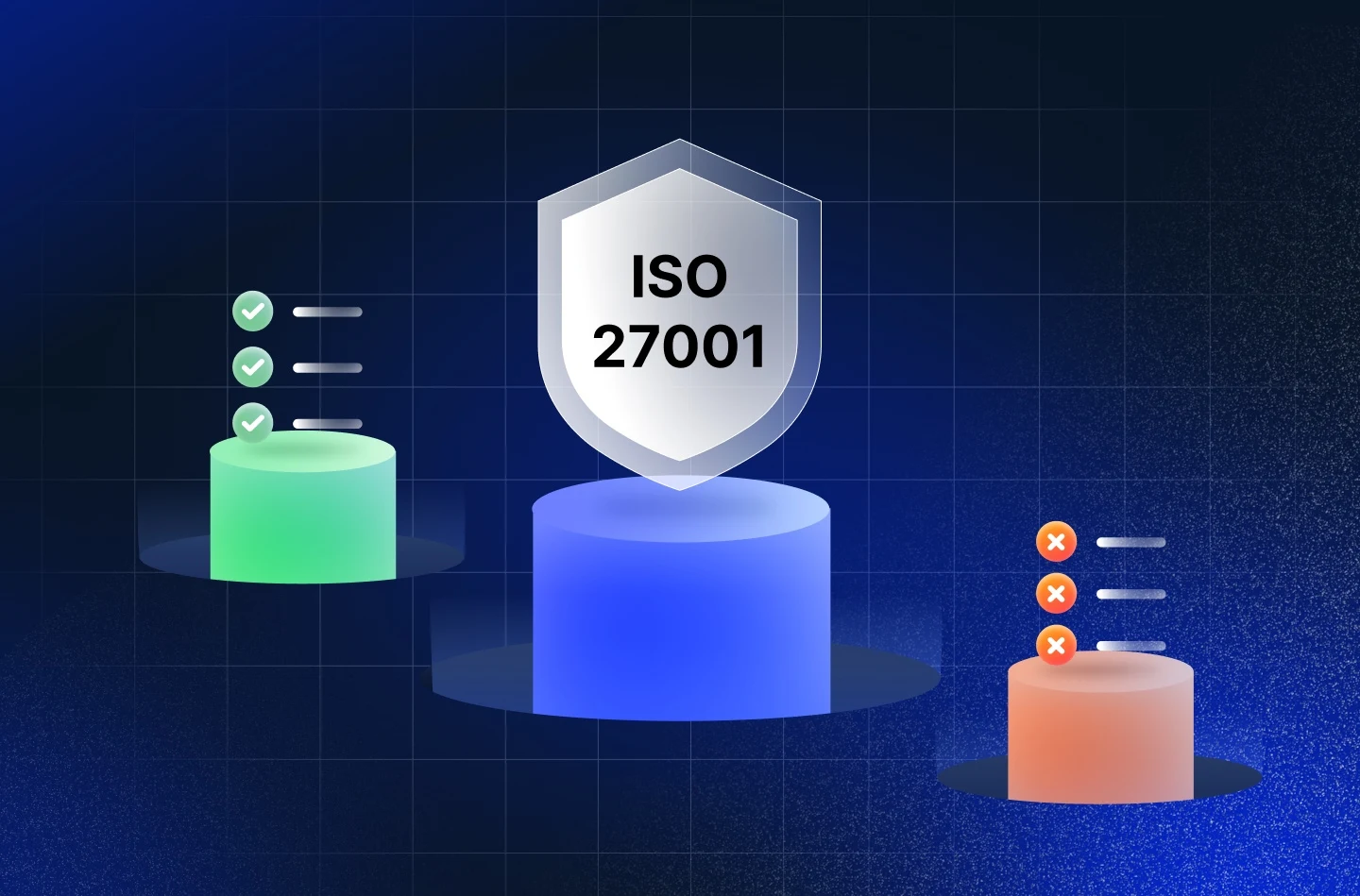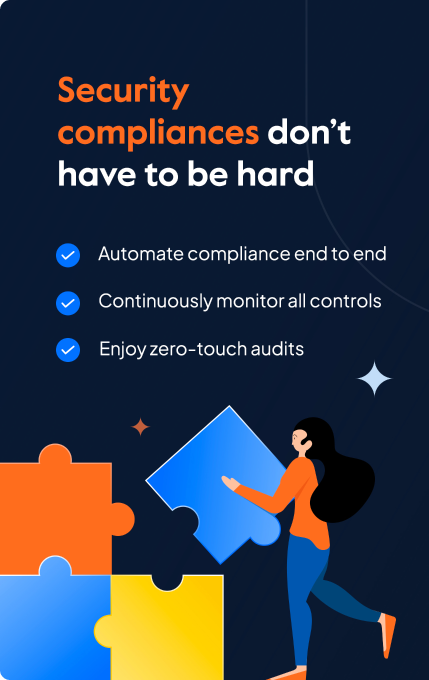The ISO 27001 certification process typically requires gaining familiarity with the standard, diligent planning, committed implementation, and ongoing maintenance.
The readiness and existing processes of the organization determine the complexity of each of these steps. For first-time certification seekers becoming audit-ready and dealing with the back and forth with the auditor after the initial audit can be overwhelming.
In this blog, we’ve penned a beginner’s guide to the ISO 27001 certification process. Let’s get started.
TL;DR
| ISO 27001 certification is a document issued by an accreditation body after the audit that confirms that the organization’s ISMS meets all the requirements under ISO 27001. |
| ISO 27001 certification steps include defining scope, conducting risk assessment, implementing controls, evaluating performance, and auditing controls. |
| An ISO 27001 certification helps build customer trust by showing them that you take information security seriously and have measures in place to safeguard critical intellectual property. |
Some of the mandatory requirements to achieve an ISO 27001 certification are:
- The implementation of an ISMS
- Frequent risk assessments
- The development of security policies and procedures
- Carrying out risk management processes
- Timely reviews of ISMS effectiveness
Who needs ISO 27001 certification?
ISO 27001 certification is essential for organizations that collect, process, or store sensitive data—especially AI-first companies handling large-scale datasets, user behavior, or proprietary models. It’s equally critical for cloud-native businesses and SaaS providers looking to demonstrate trust, meet regulatory requirements, and scale securely in data-intensive environments.
Why do you need ISO 27001 certification?
ISO 27001 is an international standard and a hallmark of efficient business practices that aim to safeguard sensitive information. ISO accreditation demonstrates a commitment to information security and adds credibility and value during customer conversations. ISO-certified organizations also avoid the financial and reputational costs related to data breach management.
Download our ISO 27001 ebook to gain a competitive edge. Our step-by-step guide will empower you to achieve certification efficiently.
Your complete guide to getting
ISO 27001 certified

Is it worth getting an ISO 27001 certification?
ISO 27001 has a global growth rate of 20% and it is a popular information security standard in the US which is seeing 78% year on year increase in the certifications.
The short answer is Yes. Thanks to the ever-evolving risk landscape, it has become a global norm for organizations to work only with businesses that can demonstrate the security of sensitive data. ISO accreditation now doubles up as a business differentiator that helps bring in new business opportunities and expand the customer base.
Becoming ISO/IEC 27001 certified goes a long way in establishing your security prowess. It gives you an overview of your organization’s security measures, policies, and practices and helps you determine the next steps to achieve an elevated security posture while optimizing expenses and resources.
Good read: 10 Best ISO 27001 Software You Need To Consider For 2024
How to prepare for ISO 27001 certification?
Preparing for ISO 27001 certification involves more than just drafting policies—it requires embedding security into your organization’s processes, culture, and risk management strategy. The goal is to build a resilient Information Security Management System (ISMS) that not only meets the standard’s requirements but also supports long-term operational integrity.
Here are the 9 steps you need to follow to get ISO 27001 certified:
Step 1. Plan your certification process
The ISO 27001 implementation process is challenging in practice and requires active participation from the entire organization. To ensure successful implementation,, understanding the requirements thoroughly and setting clear expectations from the beginning is crucial. Begin with getting the top management on board to secure buy-in from other stakeholders.
Who should be involved?
ISO 27001 is not just an IT initiative—it’s an organization-wide effort. Typically, the implementation team should include:
- CISO or Head of Security, who owns the ISMS strategy and risk posture
- IT Manager or Infrastructure Lead, responsible for implementing technical controls
- Compliance Officer or Risk Manager, to align documentation and processes with legal and regulatory expectations
- Department Heads, to ensure that operational workflows align with security requirements
- Project Manager, to coordinate tasks, timelines, and stakeholder updates
In smaller companies, one person may wear multiple hats, but the key is ensuring representation from both the technical and operational sides.
Step 2. Define ISMS scope
Defining the ISMS scope requires you to outline all processes, systems, people and technology that will undergo an assessment. Narrowing down the scope expedites the certification process and saves ISO 27001 certification costs. The organization must also provide a rationale for all the scope inclusions and exclusions for certification audit purposes.
Step 3. Conduct a risk assessment
A detailed risk assessment of your current business environment is essential to prioritize compliance-related tasks. A risk assessment gives you an overview of your business’s security posture. It helps you with the visibility required to identify vulnerabilities and prioritize them depending on the risk they pose to your business.
As a compliance automation tool, Sprinto can help here with its integrated risk management. Here’s what you get:
- A risk register which features a list of risks faced by most tech companies
- Quantitative risk assessments and mitigation steps to simplify the risk management process
- A high-level view of the risk profile for management review
Step 4. Build a security framework for implementation
With the findings from your risk assessment for ISO 27001, build a framework for implementing patches and policies. The framework will help you track progress, identify blockers, and plan your next steps smoothly. This framework will also double up in the evidence submission process when your organization submits compliance evidence during the ISO audit.
Step 5. Implementation plan
Once you’ve identified the risks and the weak zones in your business environment, you should get the ball rolling with the implementation. Define roles and responsibilities and prioritize tasks based on risk scores identified during risk assessments.
Implementation goes beyond the confines of your excel sheet. Often this involves an org-wide change and is met with resistance. Before beginning the implementation process, start introducing your team to best practices for creating a secure business environment. Conducting periodic security training programs should solve this.
Sprinto can be an enabler in this journey with its:
- Automated workflows to streamline ISO 27001 alignment processes
- In-built staff security training modules
Step 6. Evaluate performance
As you go on with the implementation, periodically analyze your performance reports to uncover ongoing vulnerabilities. Then assess these vulnerabilities to understand how they could negatively impact your final audit with an external auditor.
Sprinto can make this reporting process easier with:
A health dashboard with live status of control health to give you a quick snapshot of pending work
Step 7. Internal audit
Once you have implemented all the systems and assigned stakeholders, you continuously evaluate your compliance posture. Having your Information Security Management Systems audited by an external resource or a qualified internal auditor is an excellent practice.
This internal audit will help you get an unbiased view of your business environment and the visibility you need to evaluate the performance of your compliance program. Based on the findings from your internal audit, fine-tune your security controls and internal requirements for continued maximum efficiency.
Sprinto can be your internal audit management tool:
Define an internal audit window on the dashboard and only when you have achieved >90% audit readiness with the help of the platform, proceed for an external audit.
Step 8. Get your systems audited
An ISO-certified auditor reviews your organization’s legal requirements and operational, administrative, and technical aspects and aligns them with the requirements of the ISO 27001 process. The audit is usually done in two stages.
Stage 1: Here the auditor generally reviews your ISMS, SOA (Statement of Applicability), your security risk reports, steps to implement corrective measures, risk mitigation plans, and more. Based on how stage 1 goes, the auditor either moves on to stage 2 or asks you to work on improving certain aspects of stage 1 before moving to the next stage
Stage 2: In this stage, the auditor assesses how well the ISMS is implemented, the degree of applicability, its ability to defend against malicious attacks, and more. The auditor maps control efficiency to evidence to really ensure that the implementation plan presented on paper is what’s running on the business environment in real-time.
If the certification auditor is happy with your ISMS, protective and corrective plans and the evidence mapped against each task, and does not identify any major nonconformities. Then, they process your ISO 27001 certification.
Step 9. Implement continual improvement
Your road to IS0 27001 does not end after getting ISO 27001 certified; ensure that all your systems, security controls, and safeguards consistently meet their pre-defined efficiency metrics. As and when your compliance score toggles, address inconsistencies and ensure complete security.
Sprinto automatically recommends systems for your internal controls and suggests systems commonly used by other companies. It supports both manual and automated systems and implements role-based access controls to reduce cybersecurity risks.
When you enable automated checks for your cloud entities, the system continuously scans and evaluates them. These checks are designed to detect any unusual activity. If something unusual is found, the system initiates actions and notifies you to take further steps.
Find out how to automate the ISO 27001 certification process.
Cost of achieving ISO 27001 certification
In 2025, ISO 27001 certification typically costs between $50,000 and $200,000. The exact cost depends on your organization’s size, current security posture, scope of the audit, and chosen certification body. Smaller startups often fall near the lower end of this range, while large enterprises with complex systems can expect costs toward the higher end.
To get a more thorough estimate for your certification, check out our compliance cost calculator.
Save upto 60% on ISO 27001 audit costs
How long does it take to become ISO 27001 certified?
ISO 27001 certification usually takes 3 to 12 months.
Smaller organizations with simple systems can often complete it in under 6 months, while large enterprises with complex infrastructures may take closer to a year. Using compliance automation can reduce timelines to just a few weeks.
However, with Sprinto’s automation capabilities, our clients are able to get audit-ready in weeks. With Sprinto you can:
- Integrate your cloud stack to the platform and automatically assess risks
- Review ISMS effectiveness with control checks running throughout the day
- Leverage in-built policy templates, training modules, role-based access controls and other capabilities
- Collect evidence automatically and present to an accredited audit partner on an independent dashboard
Read how Officebeacon achieved audit readiness for ISO 27001 in just 2 weeks
Benefits of ISO 27001 certification
There are many benefits of getting ISO 27001 accreditation. The most obvious one is that it shows the world that you take information security seriously and have what it takes to keep your critical intellectual property secure.

Here are the other major benefits of ISO 27001 certification:
1. Protects you from cyber threats
To get ISO 27001 accreditation, you must create a strong security posture for your organization. This posture covers everything from conducting security training for all your employees implementing secure coding practices, and ensuring MFA is enabled. These wide-spectrum security nets make it difficult for bad actors and hackers to penetrate your defences and gain unauthorized access to your sensitive information.
2. Prevents reputational damage
Cybersecurity incidents can impact public perception as they bring negative publicity. Getting ISO 27001 certified reduces the risk of your organization becoming yet another cyber security breach statistic and helps maintain a positive reputation..
3. Adds a strategic advantage
Displaying ISO 27001 certification on your company page can make a significant difference. Compliance with a security compliance system like ISO 27001 instills trust in your prospects regarding the security and integrity of their data. This can provide a strategic advantage for start ups and medium-sized businesses when pitching to enterprise clients.
Read how Risr/ was able to sign a major government contract by getting ISO 27001 compliant with the help of Sprinto
4. Saves you from regulatory fines
ISO 27001 does not impose legal penalties and fines but here’s an interesting take. ISO 27001 is a rigorous standard that helps you prepare for other regulations like GRPR and HIPAA. ISO 27001-Compliant ISMS helps implement best practices for information security on an ongoing basis and saves you from regulatory penalties related to other data protection laws.
5. Helps build a security-first culture
Often security training programs and security activities are considered checkbox items and should be remembered after the training activity is finished. These learnings are seldom implemented. The ISO 27001 accreditation instills a culture where internal audits and security training become common. This increases org-wide awareness of security threats and how everyone in your team helps create a secure business environment.
ISO 27001 vs Other Frameworks
While many frameworks focus on compliance checklists or specific regulatory needs, ISO 27001 stands out for its emphasis on organizational behavior, continuous improvement, and embedding security into everyday operations. Here’s how it compares:
| Aspect | ISO 27001 | SOC 2 | NIST CSF | HIPAA |
| Primary Focus | ISMS and risk-based information security | Trust principles (security, availability, etc.) | Cybersecurity risk management | Healthcare data privacy and security |
| Global Applicability | Yes | Mostly US-based | Primarily US-based | US-specific |
| Certification Available | Yes (accredited certification) | No (attestation by CPA firm) | No (self-assessment or third-party audit) | No (but audits may be required) |
| Cultural Impact | Promotes org-wide security awareness and ownership | Often treated as a point-in-time assessment | Depends on implementation strategy | Focused more on compliance than culture |
| Update Frequency | Regularly updated (latest: 2022) | Varies by auditor | Evolving, tied to NIST updates | Periodically aligned with legal revisions |
How can Sprinto help?
ISO 27001 is a framework to implement and more than just a compliance checklist. It advocates the deployment of an effective ISMS to protect customer data and meet legal and regulatory requirements. Most companies find the standard hard to interpret as per business applicability and that’s where Sprinto comes into action.
Sprinto, a compliance automation platform helps you put your compliance program on autopilot. It helps you by identifying gaps in your ISMS, automating crucial compliance tasks, and making recommendations on establishing the right controls and policies for complex frameworks like ISO 27001. You can also gain expert advice on strengthening your security posture and staying compliant over the long run.
FAQs
Being ISO 27001 certified means that the organization with the certification has implemented all the technical controls and policies required to achieve global security standards. The certification proves that an external ISO auditors has audited them for the same.
An ISO 27001 certification is valid for three years. That said, organizations must conduct external annual surveillance activities and get the effectiveness of their implemented controls attested by external auditors every year.
There are 8 mandatory ISO 27001 requirements organizations will have to achieve to become ISO 27001 compliant. They are:
1. Implement a security management system (ISMS)
2. Conduct a risk assessment
3. Develop security policies and procedures
4. Risk management processes for control mapping and Implementing controls
5. Monitoring and reviewing the effectiveness of the ISMS
6. Maintain records of the ISMS
7. Communicate the ISMS to all employees
8. Train employees on the ISMS
No, ISO 27001 certification and compliance are not the same. Compliance means an organization follows the guidelines and requirements the ISO 27001 standard sets forth. Certification begins with a formal process where an external, accredited body audits the organization to verify that it complies with ISO 27001.
Yes, an individual can get ISO 27001 certified by attending relevant training courses. One such course is the ISO 27001 Lead Implementer Course, designed for advanced practitioners and consultants. Some other courses you can explore include ISO 27001 Lead Auditor, ISO 27001 Internal Auditor, and ISO 27001 Foundations.
ISO 27001 certification typically costs $50,000–$200,000 in 2025. Smaller companies can expect costs at the lower end, while enterprises with complex infrastructures, multiple locations, and broader scopes often see costs at the higher end.
Vimal Mohan
Vimal is a Content Lead at Sprinto who masterfully simplifies the world of compliance for every day folks. When not decoding complex framework requirements and compliance speak, you can find him at the local MMA dojo, exploring trails on his cycle, or hiking. He blends regulatory wisdom with an adventurous spirit, navigating both worlds with effortless expertise
Explore more ISO 27001 articles
ISO 27001 Overview & Requirements
ISO 27001 vs Other Frameworks
ISO 27001 Audit & Certification Process
ISO 27001 Management & Assessment
ISO 27001 Implementation & Automation
ISO 27001 Industry-Specific Applications
research & insights curated to help you earn a seat at the table.









